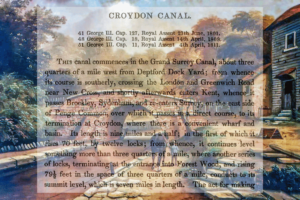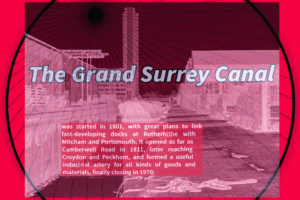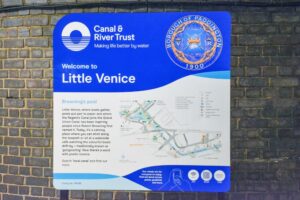The Fleet River must be the one and only natural river which enabled boats to reach any part of the inner metropolis of London, long before the Grand Junction or the Regents Canal were built. By decree of its route through some of old London’s most populated areas, the river was used as a sewer and certainly a most unhealthy waterway below Kings Cross. No doubt this explains why there is virtually no records of the boats or their trade that plied the river. Consequently its difficult to determine the extent of navigation, and when it began or ceased. The discovery of an anchor at Black Marys Hole, near Kings Cross, around the 1830’s, tells us that the Fleet River was most likely used by boats to the area.
Navigation on the Fleet River
Records show that the Fleet was quite wide and substantially deep, so it higly likely that vessels could ply from the Thames to Kings Cross, around three miles in total. It is said that the Fleet was 65ft wide at both Camden and Kings Cross in times of flood, therefore it must have been around 25 to 30 ft in normal circumstances (findings indicate that the Fleet at Battle Bridge was indeed around 28ft.) None of the other London Rivers, except the Lea, could offer such generous proportions. The use of boats began possibly prior to the 13th Century, most likely at the time of the Danes. Reports that King Canute built a second ‘canal’ to the north of the Thames may not be totaly unfounded, as it may have showed that the Fleet River was improved to enable his boats to venture on it so far north.
Navigation of the lower Fleet may extend back to Roman times. An archaeological dig by Kent University between 1988 and 1992 shows that the mouth of the Fleet in the second century AD was a important port. Two eyots existed in the estuary. The sides of the lower Fleet may have been revetted with timber, and there is evidence of a quay near to the present Ludgate Circus. There is some indication that the estuary was in fact utilised by the Romans as a pool for a tidal mill, which would make this possibly the earliest use of this form of water power in Britain. The work of tidal power ceased around a hundred years later. The Romans were noted for their excellent roads so navigation of the Fleet may have not been required during the Roman occupation of Britain. It is plausible that the earliest navigaton of the Fleet could have been around the start of 200AD. As road building skills were lost post-Roman Britain, the neccessity of using rivers became more important and certainly boats may have reached Kings Cross nearly 1800 years ago.
There is some evidence that navigation beyond Fleet Bridge (Ludgate Circus) carried on after 1197 for in that year the stone Fleet bridge was constructed. Clearly it had been built with navigation in mind for Stow tells us that prior to 1307 boats were passing under to go as far as Holburn bridge. In 1290 it was recorded that the Fleet was “becoming impure and hardly fit to drink.” By the 13th century mills were being built on the river, no doubt these would have impeded navigation hence it must be considered that the last boats reached Battle Bridge, or Kings Cross, around that time. A report of 1598 tells us that there were five bridges over the lower part of the Fleet. There is some possibility that the pre-Norman (604) and the Old St Paul’s Cathedral (1087) had stones brought by boat up to Fleet bridge. Perhaps so did Wren’s cathedral.
The Fleet Canal
By the time of the Great Fire of London in 1666, substantial lengths of the Fleet were straightened. The Fleet was given a second chance as a navigation when attempts were made to clean up its filthy condition. From St Pancras towards High Holborn, it was largely culverted. As part of those works, a wider reach was built from the Thames to High Holborn with wharfage for larger craft. This section of waterway was known as the Fleet Canal, or the New Canal as it was christened by 1674. Alas history repeats and the Fleet Canal ends up as a open sewer upon which boats hardly dared venture. It too was culverted in about 1733 or 1737 from Holbourn to Ludgate Circus (Fleet bridge.) The wide boulevard that was formed as a reult of this culverting saw the famous Fleet market established. The shorter lower section remained in use, but not for long. Following a number of drownings, this was finally completely covered over by 1765/6. The wide roadway that nowadays runs from a point south of Ludgate Circus to Holborn Viaduct sits on the former alignment of the Fleet.

Entrance to the Fleet Canal in 1750 by Samuel Scott. Copyright is in the public domain according to Wikipedia. The original is in the Guildhall, City of London.
The original entrance to the Fleet was to the west of Blackfriars Bridge, and the river ran on the west side of Blackfriars bridge road until much nearer to Ludgate Circus. (Evidence for this can be gleaned from old maps. Also from Henry Mayhew’s book – London Labour and the London Poor Volume 2 of 1851, page 406, provides further evidence.)
Further proof of the Fleet’s original route into the Thames recently surfaced in photographs of the construction of Unilever House (1929-1933) to the west of Blackfriars bridge. These showed the original course of the river and made much of the fact large amounts of water had to be pumped out before construction could properly begin.
When the Fleet was straightened and christened the New Canal, evidently a new entrance was provided further east. Another clue to the original entrance was in a road that existed prior to WWII. This road was called appropriately enough, Water Gate. The top end remnant of this is now known as Wingscote Street, just off Tudor Street. The Fleet Canal, or the Fleet Ditch, and New Bridge Road share a common alignment from the Thames to Ludgate Circus, and the present outfall of the Fleet is directly beneath the north end of Blackfriars bridge.
Beyond Ludgate Circus Farringdon Road continues to Holborn Viaduct along the Fleet Canal’s alignment. The beginnings of Farringdon Road was a boulevard placed on top of the culverted waterway in the mid 1730’s. This boulevard, which stretched as far as Holbourn bridge, was where the noted Fleet Market took place. The market opened in 1737, and lasted until 1829, when the road was widened to form what is now Farringdon Road. Despite culverting, the Fleet River made a short appearance northwards of Holbourn bridge as far as Harp Alley, in the vicinity of what is now Farringdon Station. It followed closely the present alignment of Saffron Hill, which runs parallel to, and at a lower level than, Farringdon Road.
Ben Johnson wrote a poem whose content is essentially all about shit(!) but actually its a cook-a-snook at the filthy state of the Fleet Ditch. An analysis of the poem can be read here.
The Fleet in about 1765 looking towards the bridge at Bridewell – this is clearly a pencil copy of Samuel Scott’s 1750 painting shown above.
The river with no name?
The River of Wells was a popular name for the Fleet in view of the number of wells that were found on its banks north of Clerkenwell. These were as follows, Bagnigge Wells, Black Mary’s Hole, St. Chad’s Well and St.Pancras Well. A reason for calling it the ‘River of Wells,’ as some early writers have pointed out, is due to the fact the river had no name. The name Fleet is applicable to that between the Thames and Holbourne Bridge – a referrence to the wide estuary and the fleets of Roman ships which sailed onto it. Northwards to Clerkenwell it was known as the Turnmill Stream, beyond which it did not have a name. ‘Fleet’ is the description used since the early 19th Century for all parts of the waterway north of Holborn.
For a view of the Fleet River during modification works under New Bridge Road see here, and a present day view of the same section (presumably) here. For a view of the Fleet as it enters the Thames (behind those whopping great big iron doors) see here.
Fleet River and canal pages
Blackfriars / Holbourne Bridge / Hockley in the Hole / Mount Pleasant / Baggnige Wells / King’s Cross / St Pancras Way



